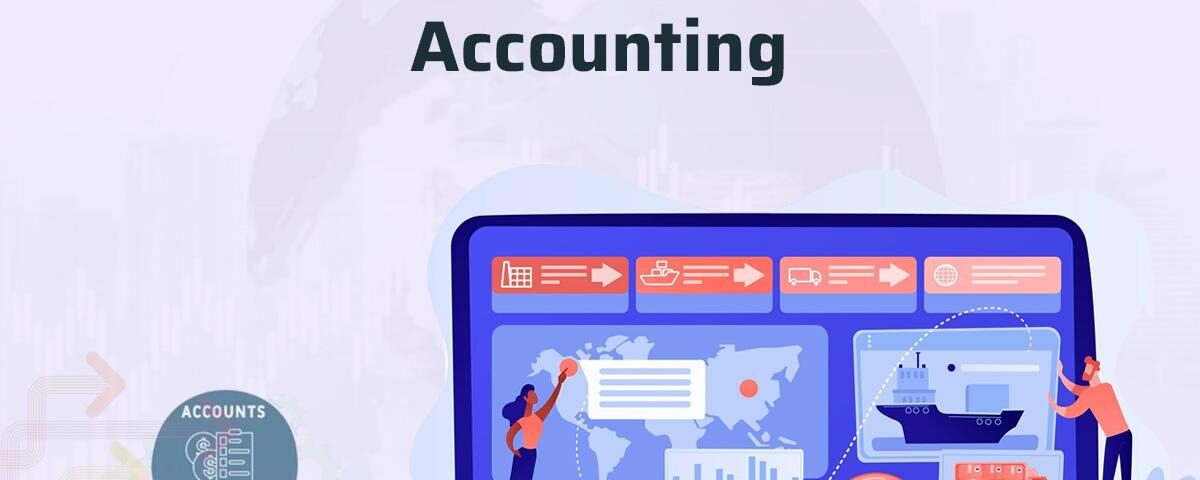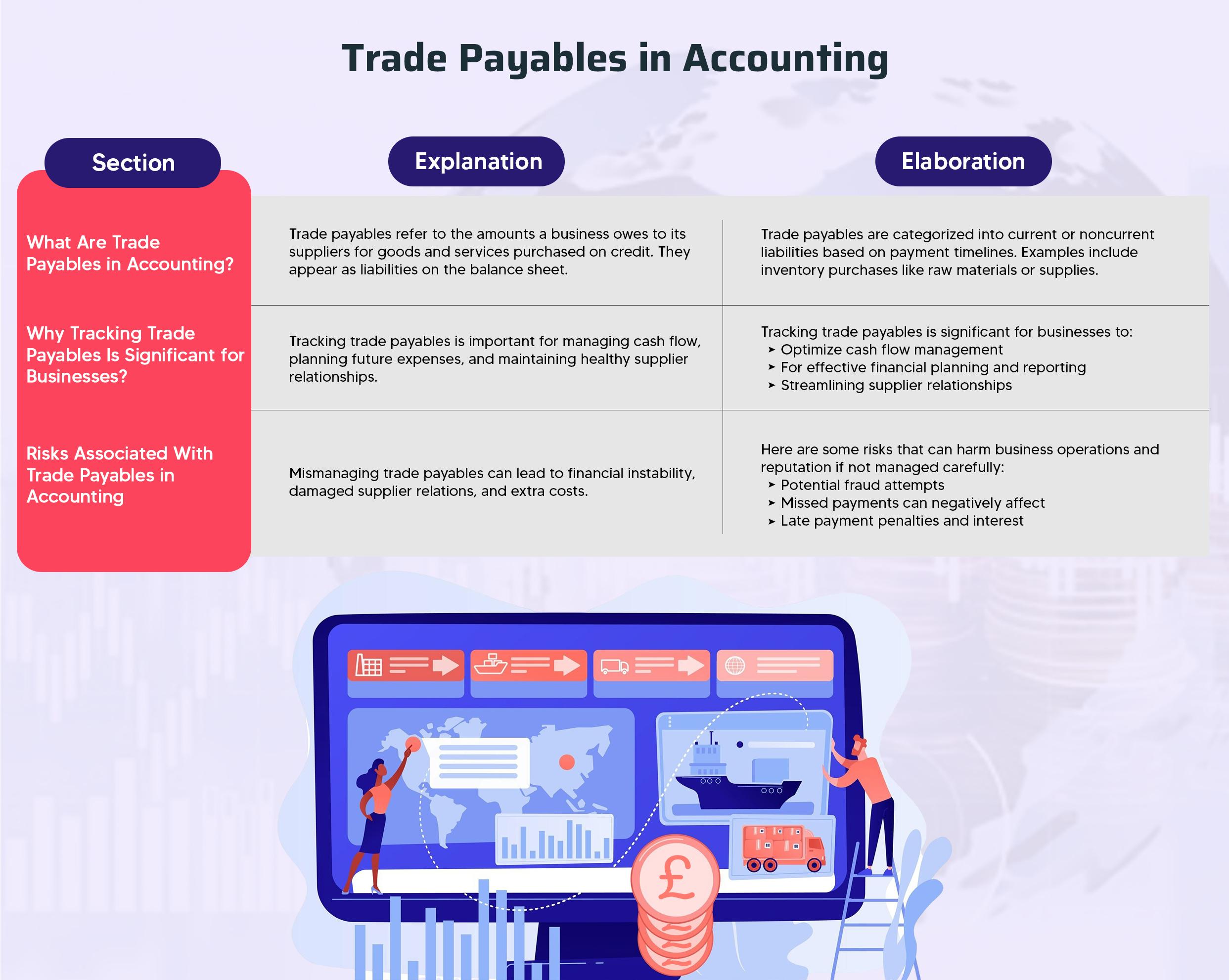
What Is an SME?
November 21, 2024
VAT on Holiday Lets
November 23, 2024Trade Payables in Accounting

Managing trade payables is essential for running a business smoothly. Has your company stocked up on inventory but struggled to make payments on time? Moreover, your suppliers have also stopped delivering, and your operations have come to a halt.
Trade payables represent the money a business owes to suppliers for goods or services purchased on credit. With them, businesses would be able to pay upfront for inventory or raw materials, which could put a strain on cash flow. Tracking trade payables properly can prevent surprises and help businesses stay on top of their finances.
To help you out, we will elaborate on what are trade payables in accounting, their significance, and the risks associated with them.

Table of Contents
What Are Trade Payables in Accounting?
Trade payables in accounting, also known as trade accounts payable, refer to the amount of money a business owes to its suppliers for goods and services purchased on credit.
When companies receive supplies or services without paying immediately, they create trade payables. These obligations typically show up as liabilities on the balance sheet and can be classified as either current or noncurrent liabilities, depending on when the payment is due.
Let’s understand trade payables examples in accounting with an example. You own a restaurant and order ingredients like tomatoes and lettuce for its daily menu; those purchases are considered trade payables.
However, if the same restaurant buys aprons for its staff, that wouldn’t be classified as trade payables. Trade payables are for items directly related to running the business operations, like inventory or raw materials.
| Section | Explanation | Elaboration |
| What Are Trade Payables in Accounting? | Trade payables refer to the amounts a business owes to its suppliers for goods and services purchased on credit. They appear as liabilities on the balance sheet. | Trade payables are categorized into current or noncurrent liabilities based on payment timelines. Examples include inventory purchases like raw materials or supplies. |
| Why Tracking Trade Payables Is Significant for Businesses? | Tracking trade payables is important for managing cash flow, planning future expenses, and maintaining healthy supplier relationships. | Tracking trade payables is significant for businesses to:Optimize cash flow managementFor effective financial planning and reportingStreamlining supplier relationships |
| Risks Associated With Trade Payables in Accounting | Mismanaging trade payables can lead to financial instability, damaged supplier relations, and extra costs. | Here are some risks that can harm business operations and reputation if not managed carefully:Potential fraud attemptsMissed payments can negatively affect vendor relationsLate payment penalties and interest |
Why Tracking Trade Payables Is Significant for Businesses?
Managing trade payables not only keeps things running but also ensures businesses avoid late fees, improve cash flow, and build stronger supplier relationships.
Here’s why tracking trade payables is important for businesses:
Optimizing Cash Flow Management
If a company is going through a difficult period financially, trade payables can offer a temporary solution to maintain daily operations without resorting to expensive loans or credit lines.
Companies can closely track trade payables in accounting and identify opportunities to stretch their payments further. Furthermore, it will help them avoid unnecessary cash shortages that could jeopardize their financial stability.
For Effective Financial Planning and Reporting
Tracking trade accounts payable also contributes to better financial planning and reporting. For example, if an item purchased on credit is still on backorder, it’s essential to know how long it may take for the supplier to fulfill the order.
Businesses can use this information to plan their upcoming expenses more effectively and avoid unexpected cash shortages.
Additionally, trade payables play a significant role in the preparation of financial statements. Properly classifying current and noncurrent liabilities on a balance sheet helps create a clear financial picture of a business’s obligations.
Businesses can adjust their financial strategy to avoid long-term negative impacts if a large portion of trade payables is overdue.
Streamlining Supplier Relationships
Maintaining a healthy relationship with suppliers is vital for long-term business success. Trade payables in accounting allow companies to manage their payments accurately and avoid missing due dates.
An organized system for tracking trade accounts payable helps businesses stay on top of their obligations and maintain a positive reputation with suppliers. On-time payments, in turn, can foster trust and even result in better future payment terms or discounts from suppliers.
Moreover, a well-managed accounts payable system ensures that invoices match payments, reducing the chance of disputes.
Risks Associated With Trade Payables in Accounting
Mismanagement of trade payables in accounting can lead to financial instability, damage supplier relationships, and result in additional costs that can hurt your bottom line.
Let’s take a look at the risks associated with trade payables in accounting:
Potential Fraud Attempts
Invoice fraud is a common risk businesses face when managing trade accounts payable. For example, a business might receive duplicate invoices or invoices for goods that the supplier never delivered. In some cases, fraudsters may try to redirect payments to their bank accounts by impersonating a legitimate supplier.
Researching vendors, asking for referrals, and looking up online reviews can help you avoid falling victim to fraud. It’s also a good idea to set up secure systems for processing payments and monitoring invoices to detect discrepancies before they become a problem.
Missed Payments Can Negatively Affect Vendor Relations
Another risk is the possibility of missed payments, which can damage a business’s relationship with its suppliers. If payments slip through the cracks or you delay them repeatedly, the company may lose suppliers’ trust, and they may hesitate to continue business.
To avoid this, businesses should invest in trade accounts payable software to automate the tracking of invoices and payment due dates. With this technology, companies can ensure that payments are made on time, minimizing the risk of missed deadlines and maintaining strong vendor relationships.
Late Payment Penalties and Interest
Late payments often come with penalties and interest charges, which can have a significant impact on your company’s cash flow. If a business fails to make payments on time, vendors will typically charge late fees or interest on overdue amounts. These additional costs can quickly add up and diminish the financial benefits of buying on credit.
Businesses can avoid unnecessary penalties and interest by making payments according to agreed-upon terms. They need a reliable system to track payment due dates, monitor outstanding balances, and pay vendors promptly.
Conclusion
Companies that effectively track their trade payables can improve financial forecasting, optimize cash flow, and maintain healthy vendor relationships. Thus staying organized and proactive with payables can help businesses maintain financial stability and keep operations running smoothly.
However, businesses must be cautious about the risks involved, such as fraud, missed payments, and late fees. To minimize these risks, it’s essential to invest in tools and systems that streamline the management of trade payables in accounting.
Automating your trade accounts payable process can save you time, reduce the chance of human error, and keep your business in good standing with suppliers. Start tracking your payables more efficiently today to see the benefits of improved financial management.
